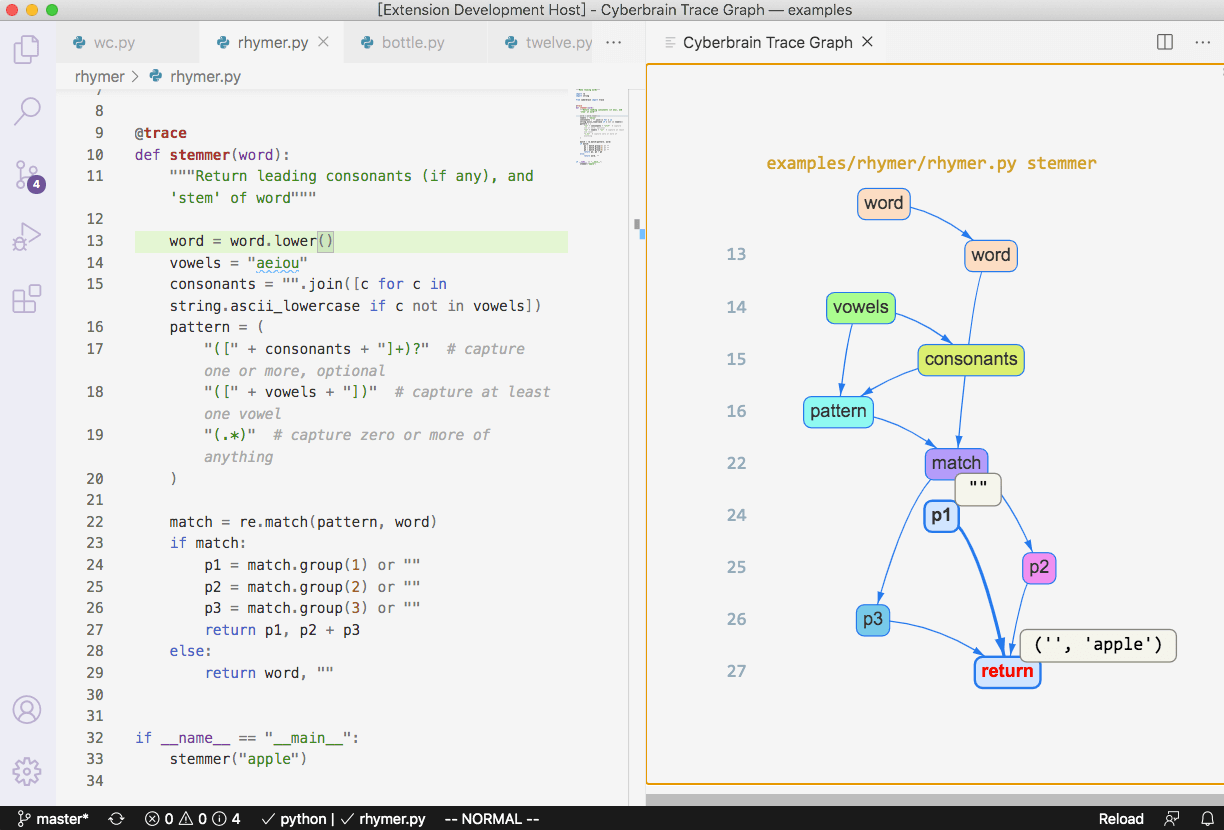Python 3.12 已经发布了一段时间,所以写篇水文来聊一聊这个常常被人忽略的史诗级版本。
正文
Python 3.12 绝对是一个史诗级版本,在我心目中,它对于 Python 的意义,大于 “async/await” 的 Python 3.5 和 “Type Hint” 的 Python 3.6 对于 Python 的意义。
或者我们可以这么说在未来数年的时间里,Python 后续的很多意义重大的变更,其都能上溯到 Python 3.12。
理解我这一个观点,我们来说一下 Python 的几大痛点:
- Python 的可调试性,可观测性问题。历史上 Python 中做 Cost 的消耗极大,同时没有足够的手段可以从旁路去观察 Python 的运行时行为
- Python GIL 问题,这个老生长谈了,不多说
- Python 的 C API/ABI 问题,之前暴露的 C API/ABI 通常和 CPython VM 实现细节耦合,导致跨版本兼容性会是一个问题
而这样一些问题,Python 3.12 上都有了极大的进步
- PEP 669, GH-96143 极大提升了 Python 的可观测性,可调试性
- PEP 684, A Per-Interpreter GIL, 提升 Python 进程内性能,为后续的 non-GIL 打下了良好的基础
- PEP 697 全新的 C API,进一步解耦 API/ABI 与 CPython VM 实现细节的耦合
我们下面分别来聊聊这一些变更
可观测性的提升
先聊聊 PEP 669,PEP 669 其实是受 PEP 659 启发的一个 PEP。在此之前,Python 内部事件的监控非常的困难,或者说代价极为高昂。以之前 laike9m 做的 Cyberbrain 这样一个工具来说,它能实现如下的调试效果
通过这个功能能很方便的调试函数的各种调用栈和入参。实际上这样的实现整体上基于 sys.settrace 这样一套 API 来做的。会非常的慢,原因是在于每一个栈帧的调用都会触发一次 sys.settrace 的调用,可谓是在主干道上疯狂堵塞了。
而 PEP 669 则不一样,它存在两种 level
- Global Callback
- Code Block Callback
换句话说,可以让我们根据场景来选择不同的实现粒度(按照官方的 Benchmark,比 PEP 523 快了数个数量级)
同时 PEP 669 也实现了完整的一套 Event 语义
- PY_START: Start of a Python function (occurs immediately after the call, the callee’s frame will be on the stack)
- PY_RESUME: Resumption of a Python function (for generator and coroutine functions), except for throw() calls.
- PY_THROW: A Python function is resumed by a throw() call.
- PY_RETURN: Return from a Python function (occurs immediately before the return, the callee’s frame will be on the stack).
- PY_YIELD: Yield from a Python function (occurs immediately before the yield, the callee’s frame will be on the stack).
- PY_UNWIND: Exit from a Python function during exception unwinding.
- CALL: A call in Python code (event occurs before the call).
- C_RETURN: Return from any callable, except Python functions (event occurs after the return).
- C_RAISE: Exception raised from any callable, except Python functions (event occurs after the exit).
- RAISE: An exception is raised, except those that cause a STOP_ITERATION event.
- EXCEPTION_HANDLED: An exception is handled.
- LINE: An instruction is about to be executed that has a different line number from the preceding instruction.
- INSTRUCTION – A VM instruction is about to be executed.
- JUMP – An unconditional jump in the control flow graph is made.
- BRANCH – A conditional branch is taken (or not).
- STOP_ITERATION – An artificial StopIteration is raised; see the STOP_ITERATION event.、
对比一下 sys.settrace 提供的事件
- call
- line
- return
- exception
- opcode
什么叫又新又好啊?通过 PEP 669,我们可以很方便的去实现性能更好的调试器,低成本的对 hot path 进行调用统计等很多操作
PEP 669,先告一段落,接着继续往下聊,GH-96143,也是一个贼为重要 PR
我们都知道,对于解释性语言在旁路 trace 最难做的一个事情,就是你很难能将内存中的地址和现在执行的代码关联起来(因为直接地址是没有意义的)。而 GH-96143 则是做了一个极简化的 JIT,将 Python 的 code block 和内存地址锚定,可以让我们在旁路直接 trace 内存地址。一个效果
1 | 7f0caf8aa70c b py::_path_abspath:<frozen importlib._bootstrap_external> |
具体的实现可以参考我另外一篇文章,这里就不展开了。终于算是补全了其余语言已经出现很早的功能了
GIL 的改进
众所周知,Python 祖传的被黑的的地方是 GIL,或者说 GIL 给它带来了很多比如简化开发者代码心智负担的优势以外,也给带来额外的黑点。在降本增效,啊不对,性能提升越来越重要的今天,我们需要来尽可能的规避 GIL 所带来的性能问题
但是 GIL 不是那么好移除的,因为 Python 不少的状态都是全局状态,其设计的一部分假设就是 GIL 所带来的线程安全性,很典型的例子有
- GC
- 内存分配器
- 不同对象的安全性等
在我们继续推进 non-GIL 之前,我们需要将关键状态从全局解耦。PEP 684 其实就是起到了这样的作用。除了引入 per-interpreter 的 GIL 以外。它最重要的意义莫过于将包括 GC 状态在内的一系列关键状态,下放至 interpreter 的级别。为后续的 non-GIL 落地打下了很坚实的基础
C API/ABI 的改进
Python C API/ABI 一直是一个老大难问题,因为一度和 Python VM 的 API 耦合的非常紧密。Python 官方也意识到了这个问题,从 Python 3.2 引入 Limited API,到 PEP 652 ,Python 一直在试图提供稳定,跨版本的 API,但是始终有一环没有闭环,那就是对于类型的处理
比如说,我们 Rust/C++ 之类的 Binding,通常可能会在 Python 标准类型的基础上进行一部分派生,中间存入自己的状态。那么我们最开始的写法是(也只能是)
1 | typedef struct { |
那么你觉得这段代码有什么问题吗?可能你发现了,这段代码,直接依赖了 Python 的 PyListObject,这样一个数据结构实际上是内部的实现细节,它的内存布局,兼容性随时可能随着版本变化而变化。所以 PEP 697 就尝试去填补上 Python Stable API/ABI 这最后一环
在 697 后,我们可以这样实现我们的代码
1 | typedef struct { |
我们能看到,我们能直接将我们想要在数据结构中扩展的部分直接 attach 到基类上,而无须关心其细节。这样一来,我们就能够在不同版本的 Python 上,保证 ABI 的兼容性了
总结
很多人在去判断一门语言新版本的时候,会从语法糖等角度去判断,但是我自己更喜欢从它的稳定性等常常被人忽略的角度去判断。我对于 Python 3.12 的一个最直观的评价就是在可观测性,调试性,API/ABI 稳定性上,终于和其余语言站在了同一水平线上






